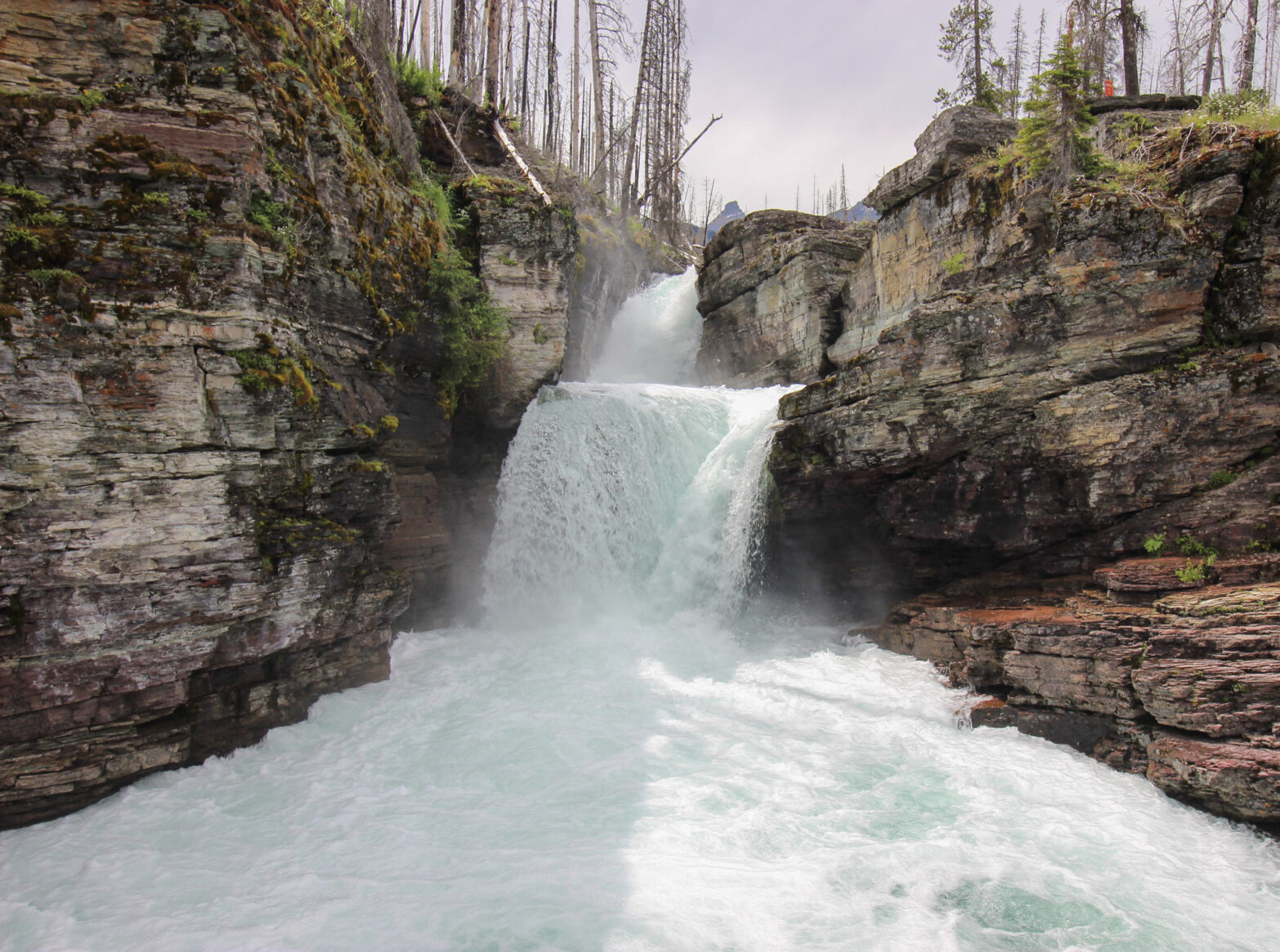A little rubbery in the knees, but otherwise alright. That was my self-assessment inside the RAV-4 at Siyeh Bend as we sat out the angry spits of rain. It was only early afternoon on July 15, and Elizabeth and I faced the age-old question: what to do now that we’d finished a 9-mile hike several hours faster than I’d dreamt we could due to fear of the bear below us? Now, I previously mentioned that we had not obsessively researched Glacier National Park. That’s true, but it’s not like we knew nothing. There were some target hikes that both of us wanted to see. One of them was up at Logan Pass, where the Hidden Lake Trail is probably the most-trafficked alpine trail in the US. Maybe after the traffic didn’t seem too bad yesterday, we could luck our way into a parking spot again today up at Logan.
What a joke that statement was. It was far from empty at Logan Pass, but there were a ton of spots available at 2:00 p.m. on a Friday. Could you blame a lone rain shower for this? The closure of GTSR only being lifted 2 days prior, not letting people adjust back? Do people just overstate the amount of little piggies at Glacier? (Note: I think it was the second one.) Either way, there wasn’t an issue finding any parking. What we needed was a ranger to tell us when the Hidden Lake trail would open. It took a little while inside the crowded Logan Pass Visitor’s Center (very cool visitor’s center, very depressing climate change exhibit) to get one’s attention. Their answer for when the trail would open? A verbal shrug. We’d wasted our time.
Well, there’s maybe nowhere better on earth that we could have wasted our time. None too put out, I suggested that we take GTSR the rest of the way down its length and get to our campsite at the St. Mary campground.
The skies began to clear on our downhill drive back to the east. It was incredible how much stuff had happened in the 54 or so hours since Elizabeth and I had driven this road bright-eyed the opposite way. It had been an exhausting trip so far, but the two of us couldn’t stop repeating that this national park was without compare among any we’d visited. I still think that’s true as I write this 8 months later.
As we got to the upper side of St. Mary Lake, I saw that waterfall in the distance that I’d seen a few days ago. It still seemed to be absolutely spewing water off the mountainside. Looking out the window probably helped, because I suddenly noticed – there was an open parking spot here at the St. Mary Falls trailhead. Immediately, I pointed. “Parking spot”. Elizabeth needed no further encouragement, whipping into the opening. No, this was not going to be part of the plan at all. But any of our (ok, it really was pretty thorough) research had all led to the same conclusion: if there’s parking available at the St. Mary Falls trailhead, you take it. That isn’t going to happen often.
So that’s how I ended up here along the banks of an impossibly blue lake, standing on impossibly red rock, getting ready to finish an impossibly long day of hiking.
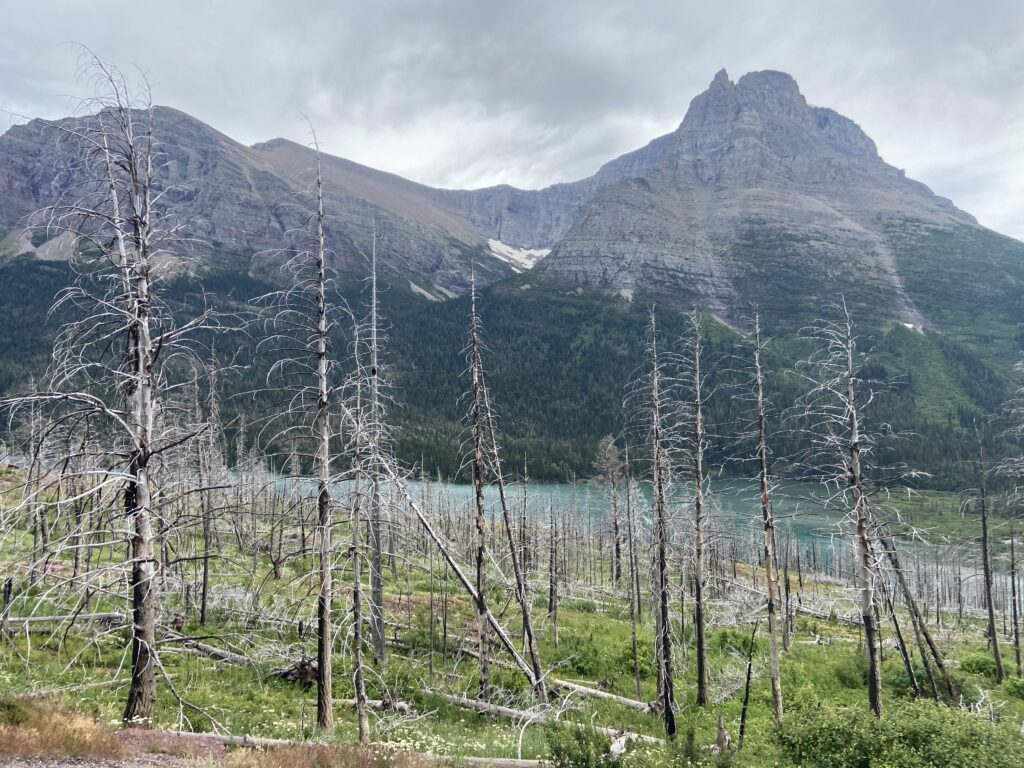
The St. Mary Falls trail leads downhill from the parking lot to the river level on a general southwesterly track. Along the way it crosses many of the ubiquitous trickles that come out of the higher terrain to your right. This trail was paved with maybe the most brilliantly colorful stones I saw in all of Glacier. Most of them were a hue somewhere between red and violet, but the other great colors of Glacier came out at times.
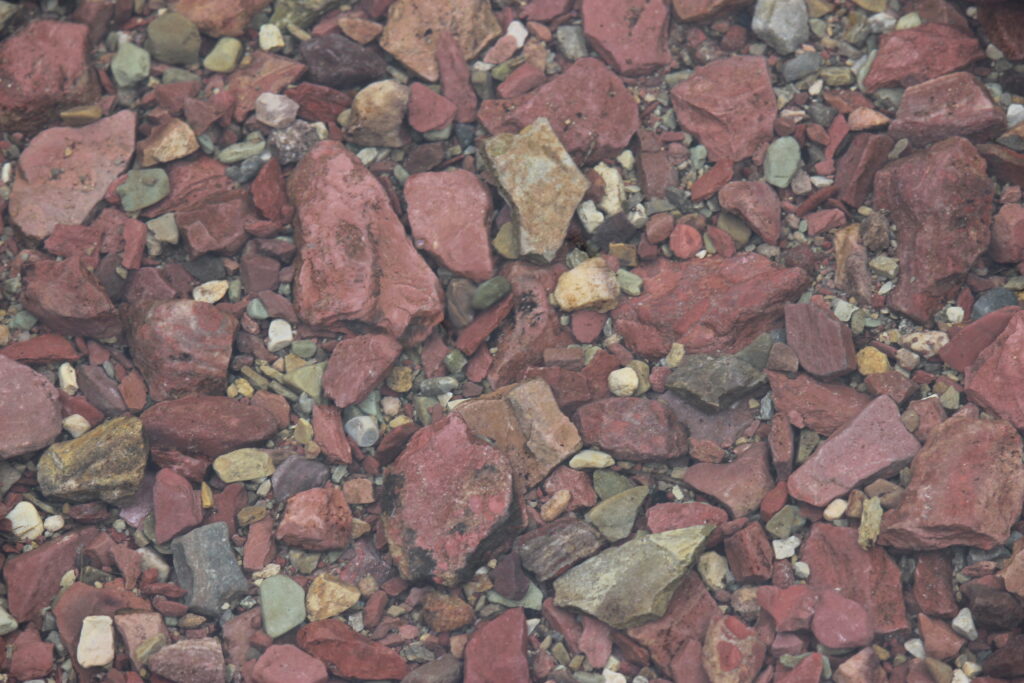
The trail is also notable for passing through a burn scar from a 2015 wildfire. You can see it in the picture above, and that’s kind of how the whole northwest bank of St. Mary Lake looks – these black trees, with only the bigger branches remaining, still standing where they torched 7 years ago. Meanwhile, many of their felled brethren lie on what used to be the forest floor below. Now it isn’t a forest floor that they lie in – it’s an emerging meadow, where ferns, flowers, and bushes are springing up ever more each year. We’ve spent so much time thinking about the western wildfires of the late 2010s and early 2020s as a bad thing – climate change personified. That’s not entirely wrong either. But here, on this trail, I got to see that wildfires are also a good and necessary part of a healthy alpine environment that we’re starving out of too many wild places.
There were also quite a few more of the little piggies. This was a family friendly trail, but that doesn’t mean the family is friendly on the trail. I passed harried moms trying to corral their small kids, old people completely out of shape, all sorts of piggie behavior.
As blue as the head of St. Mary Lake is, the St. Mary River itself is even bluer. Unlike the purely chaotic flows of other streams and rivers in the park, this one hurried in a stately fashion from our vantage point. Now that we were here, the Falls should be any second… right? Right? I’m gonna chalk this one up to tired legs and tired minds, because on that day the two of us swore the trail was longer than what the NPS posted signs said.
Eventually the river began flowing toward us more swiftly than it had before. Up ahead, the trail crossed the St. Mary River along a wooden footbridge. Just beyond that, the telltale roar of water plunging off a cliff announced that we were almost there. Just a short walk later, Elizabeth and I discovered that we had hit a real jackpot of timing: there was nobody else on the rock outcropping directly in front of the waterfall.
St. Mary Falls gets a very solid 8/10 rating for me. The colors were just so vivid. It’s like a saturation-obsessed photographer’s dream, similar to the one on Avalanche Creek several days prior. The water is a brilliant blue whenever you see it poking through pure-white foam. Meanwhile, the rocks framing each side of the falls seem to almost be the color of wine, and those in turn are framed by brilliant-green vegetation. The lighting was perfect for photography, though I could not have known it at the time. Please enjoy some of the very best pictures that I have ever taken.
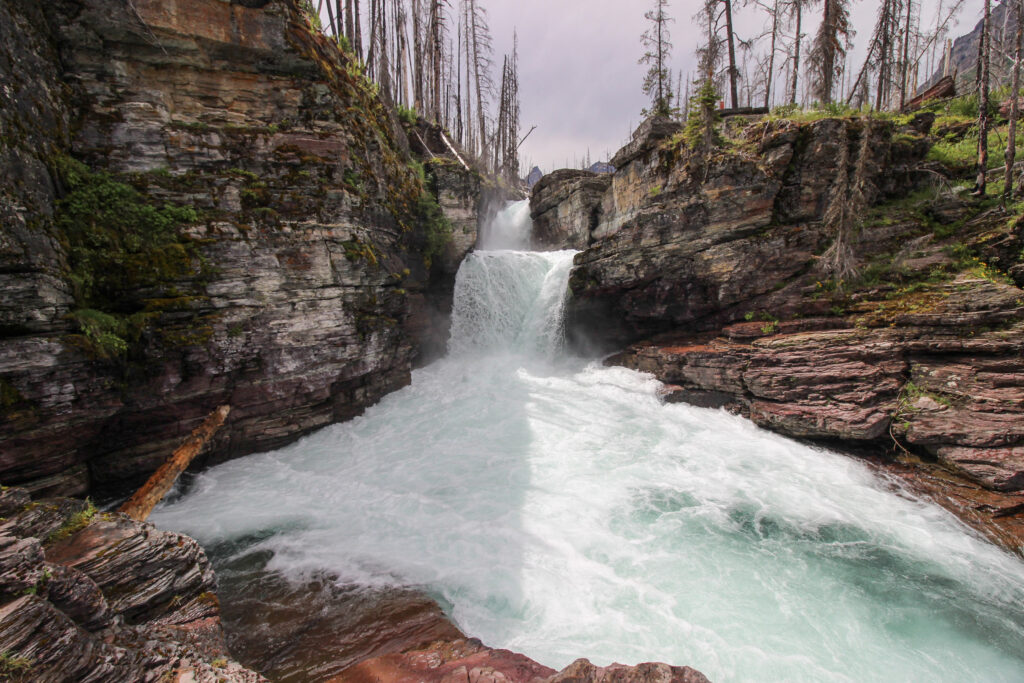
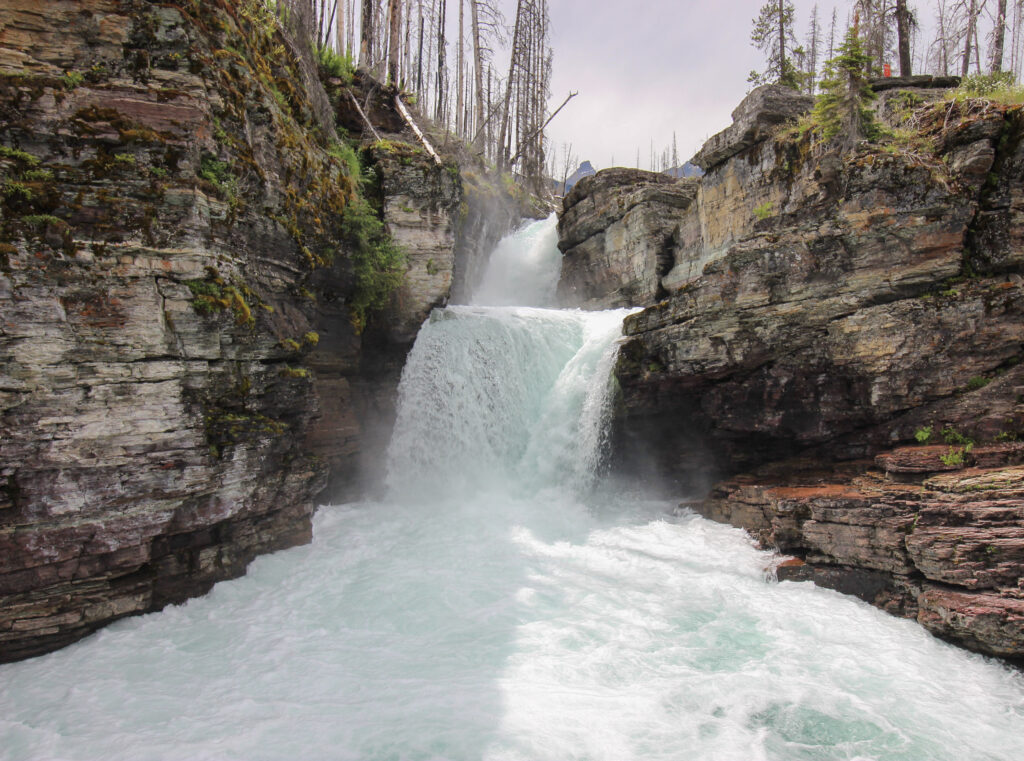
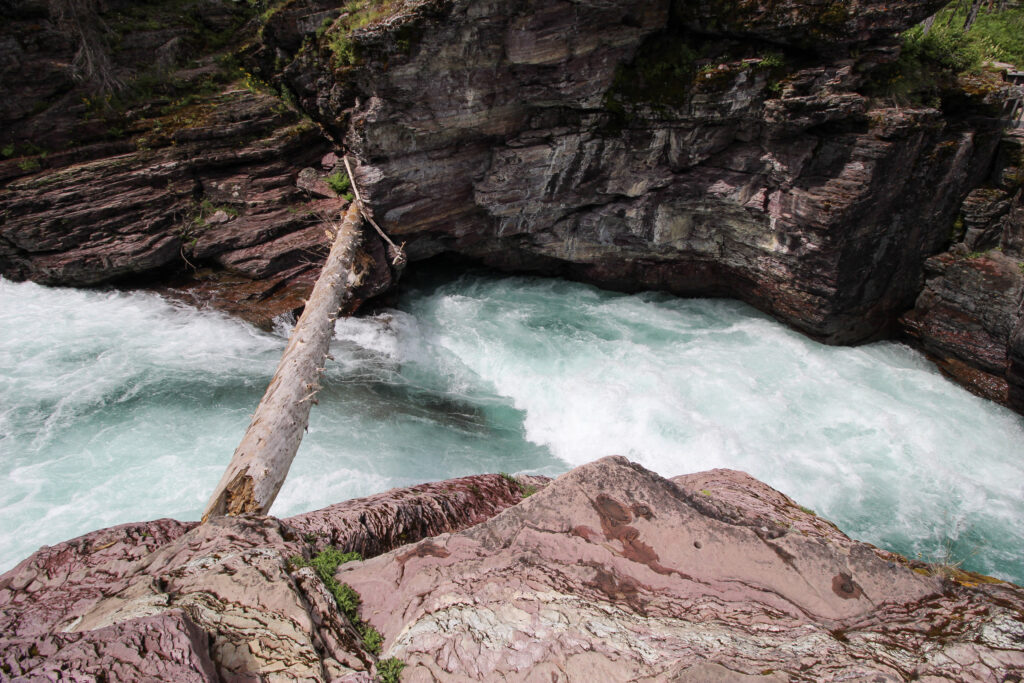

That’s just the kind of color that you can’t beat. The Gatorade-blue spray from the waterfall covered Elizabeth and myself in a delightfully frigid mist. Given the amount of hiking we’d done that day, and how warm it honestly was at the lower elevations of the park, it felt pretty damn good. I could have sat there for a while and just relaxed.
In fact, we may have done that very thing if there wasn’t one last stop to make on this adventurous day of hiking. Another mile or so up (and I do mean up) the trail lay another famous waterfall – Virginia Falls.
